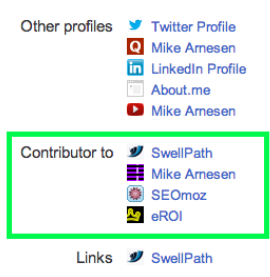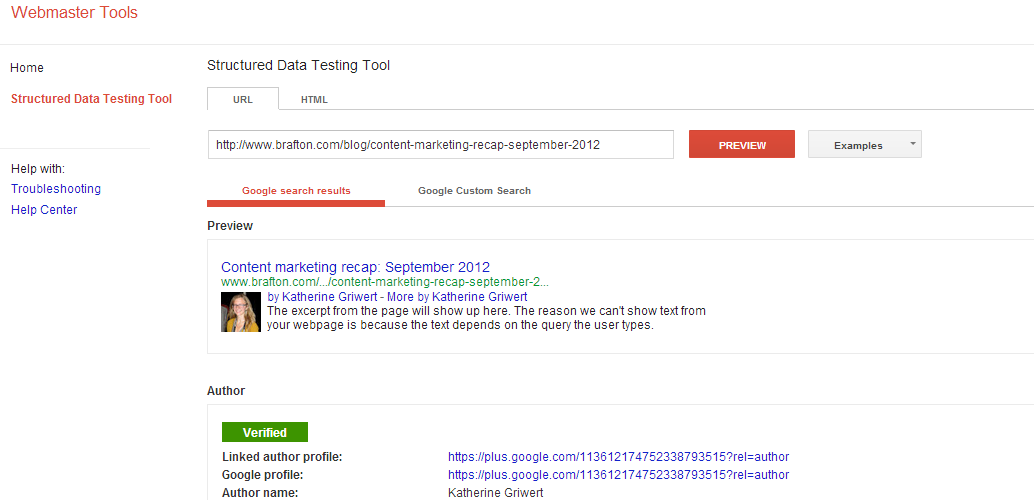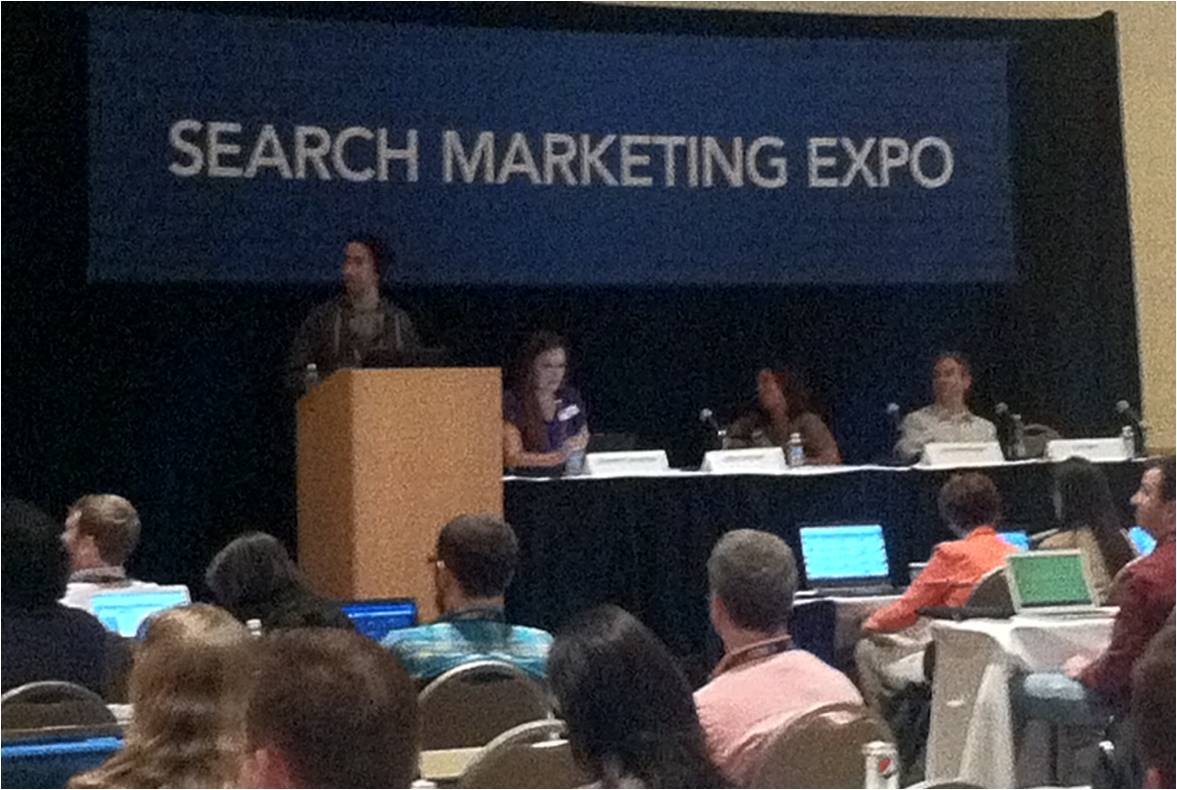Penguin and Panda have made long strides in clearing spam from the search space, but is the Google zoo just the beginning of the quality content mandate? On day two of SMX West, Mike Arnesen (Senior SEO of SwellPath), AJ Kohn (owner of Blind Five Year Old) and Lisa Weinberger (Director of Content Promotion at Bankrate) answered marketers’ burning questions about authorship and the still mysterious AuthorRank.
The session offered need-to-know basics, and the speakers also offered up some tips on how to make the most of authorship to get authority as a content creator. The underlying theme was that whether AuthorRank exists or not, there are benefits to putting a face to your content (for brand or personal visibility).
Will authority count for SEO? (Is AuthorRank real?)
Although AuthorRank doesn’t currently exist, Arnesen started the session with by theorizing about how Authorship could impact SEO. He referenced Bill Slawski‘s review of Google’s Agent Rank patents. Google wants a way to affiliate people with content via “digital signatures.” Although Arnesen didn’t go into too much depth on this, here is an excerpt from the 2011 patent abstract:
The techniques include receiving multiple content items from a corpus of content items; receiving digital signatures each made by one of multiple agents, each digital signature associating one of the agents with one or more of the content items; and assigning a score to a first agent of the multiple agents, wherein the score is based upon the content items associated with the first agent by the digital signatures.
But how can Google acquire digital signature? Through Google+ authorship markup.
The Google+ authorship feature enables content creators to connect their work across the web, and Google has already sent verified authorship messages to a growing number of users. As Arnesen pointed out, Google authorship is a way for content creators to tell Google about themselves, get recognized as authors and slowly build authority. Author accountability/ credibility could become a way to measure quality.
Later in the presentation, AJ Kohn pointed out that Authorship is NOT AuthorRank … but it seems likely this will happen. Why? He quotes the company blog post on the release of Authorship, which states:
… We’re looking closely at ways this markup could help us highlight authors and rank search results.
The experts all agree that marketers have to be prepared for not if but when AuthorRank becomes a search ranking factor – and now is the time to work on it. Here’s how.
What’s a bulletproof Google Authorship implementation?
Google’s Webmaster support bin has a page on author information in search, and Arnesen offered two simple steps to get it set up. (He also provides a more thorough overview of how to implement authorship in an earlier SEOmoz post). To set it up:
- Fill in the “contributor to” portion of your Google+ page to for every web publication featuring your (bylined) content.

- Two options:
- Set up rel=author from content on a site to the author’s Google+ Page
- Set up rel=author from content to an author “about” page, then rel=me from the about page to the author’s Google+ account
AJ Kohn suggested content creators and site owners use the structured data testing tool to verify it works.

Authors may not see their snippets right away, Arnesen warned. They need to build up a portfolio of web content.
What determines an author’s rank (for AuthorRank)?
“There are not short cuts with authorship!” said Arnesen. He offered some ideas about what Google (and users) might consider signs of strong authority, including:
- Frequency and volume of social shares for given pieces (perhaps especially +1s)
-
An author’s Google+ following
-
Comments around posts from an author, and reception of an author’s comments on other sites
-
Posting frequency
The biggest tip he gave marketers for building authority (beyond investing in creating quality content) was working on offline connections that can have online impact. He recommended good old-fashioned networking – it’s still alive and well on the web.
What do marketers really need to know to get started?
Up next, AJ Kohn offered a no nonsense overview of the “But’s” and “What If’s” with Authorship and AuthorRank. He said businesses can’t look for reasons not to get started, instead they must focus on the logistics for getting Authorship up and running.
- Can anyone be an author?
Yes! Anyone with something to write can be an author. Fetch as Googlebot will speed things up to get your authorship expedited: Authorship doesn’t apply until Google crawls everything and sees the markup
- Does old content qualify?
Yes – put authorship in place, and get credit for older stories as well as new ones.
- Can any content be authored?
Only posts written by a single author should be bylined – not broad company pages.
- Can I get a ghostwriter?
You can – but know that you, as an individual, have to live up to the expertise of the posts. (Read more on ghostwriting in a related Brafton post.)
- Do I have to do this?
While he said no one has to do Authorship, he likened asking if a company has to do it to the question of the early 90s, “Do I need a website?”
- Can you have multiple authors for a single post?
Not yet.
- What happens if an author leaves?
Just because someone leaves doesn’t mean they haven’t created content that can help a brand. If you can keep authorship in tact, you’ll still borrow the author’s authority for the pages they created on your site.
- Can you change authors on a piece of content?
Kind of … Google might ultimately catch on, but for the moment it’s possible to change an author after a piece has been published.
- How do you know it’s working?
You might get an email from Google, or you can use the structured data testing tool. In general, he forewarned marketers that authorship is brittle – if you have too many rel=authors on your author page, Google may need to adjust.
- Does Bing have Authorship?
Kohn pointed out that Bing has tagging features, but they don’t work the same way Authorship does (and he finds they only appear when he is logged into Facebook).
What do Authorship and AuthorRank mean for brands?
This is all great information for individual content creators – who can significantly help expand their brands’ visibility – but what does it mean for the companies publishing authored content? Kohn pointed out that there are whispers of rel=publisher becoming a signal to help brands perform better in rankings over time thanks to well-authored content on their sites. An individual’s presence on a branded page might have impact for the overall brand.
Arnesen also added to this conversation, reminding marketers and website owners that Authorship is about people. A Brand’s authority and the Google+ Page icon appearing on SERPs have similar benefits, but it’s not the same as seeing the face of a person you know or recognize next to a result. (How much do images actually impact interaction on SERPs? The presenters didn’t have hard figures, but eyes are drawn to visuals … Brafton has reported that content marketing campaign clicks get a 47 percent lift when articles are accompanied by photos.)
Personal branding and click-through rates alone are reason enough to get started with Authorship.
What if AuthorRank never happens?
It doesn’t matter. Even if AuthorRank never comes to pass, there are clear benefits to having an icon next to results in search. Personal branding and click-through rates alone are reason enough to get started with Authorship.
How can my company connect with influencers to promote content?
Lisa Weinberg, an Authorship user across her branded sites, shared some tips on building online connections that can help promote your authored (or unauthored content). Her presentation had some great insights on extending the shelf life of website content, and for marketers interested in Authorship and networking, she gave advice on data mining for Authority influencers.
Authority influencer: A person with inherent value, thought leadership, persuasion and expertise in a given space, operating online.
What’s the value of an Authority influencer for branded content?
- Community building
- Social signals
- Links
- Syndication
- Attribution
Marketers should focus on finding influencers with authority on relevant topics and target their searches to influencers on specific social or publishing networks. She offered five steps to building contact (without stalking) online infuencers:
- Define the users you’re interested in contacting.
- Consider appropriate conversation topics. Check out their blogs and look for common ground.
- Interact. Retweet their posts, comment on a piece they wrote or give them some form of amplification.
- Communicate. Keep it professional to protect your brand, and email or phone call (nicely fitting with Arnesen’s point about using offline networking to build web authority).
- Collaborate. Find content opportunities that make sense for both parties.
She concluded by saying authors should get on Google+ – do you need more convincing?
Stay tuned for Brafton’s continued coverage of SMX West.




